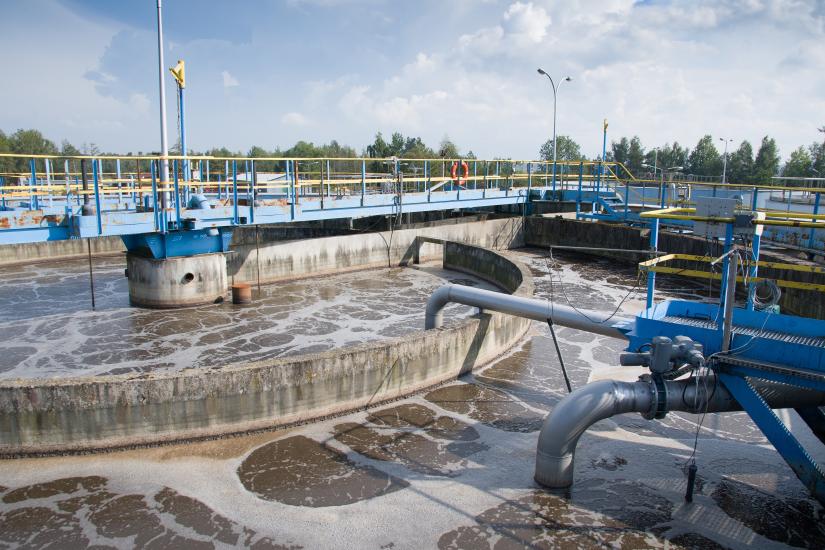Researchers from the UTS Institute for Sustainable Futures estimated just three wastewater facilities could fill 20% of the identified anaerobic digestion capacity gap required for Sydney by 2030.

Wastewater facilities are normally built with excess capacity to meet future demand and so could be used to handle food waste. Photo: Adobe Stock.
Most Australian food waste ends up in landfill. Rotting in the absence of oxygen produces methane, a potent greenhouse gas. While some facilities capture this “landfill gas” to produce energy, or burn it off to release carbon dioxide instead, it’s a major contributor to climate change. Valuable resources such as water and nutrients are also wasted.
Composting food waste is the most common alternative. In the presence of oxygen, microbes break down food and garden organics without producing methane. The product returns nutrients to farms and gardens. But composting facilities are limited and struggling to cope with contamination from plastic.
We analysed the capacity of three wastewater facilities in Sydney to process organic wastes from surrounding households and businesses.
We found processing at the wastewater treatment plants could cut 33,000 tonnes of emissions and capture 9,600 tonnes of nutrients. All 14 wastewater facilities in Sydney could be modified to accept food waste, reducing emissions and producing renewable energy.
Why process food waste at wastewater facilities?
Most wastewater facilities in Sydney use “anaerobic digestors” to treat sewage. Along with producing energy, this type of processing produces nutrient-rich biosolids that can be used for soil conditioning and as fertiliser.
Wastewater facilities are normally built with excess capacity to meet future demand and so could be used to handle food waste.
When the New South Wales government recently assessed the infrastructure needs to process food waste for the Greater Sydney Area by 2030, it identified an additional 260,000 tonnes per year of anaerobic digestion capacity is needed, on top of additional new composting infrastructure.
Currently, there is only one commercial anaerobic digestion plant in Sydney with a processing capacity of 52,000 tonnes per year.
Our study estimated just three wastewater facilities could fill 20% of the identified anaerobic digestion capacity gap required for Sydney by 2030.
Overseas, it is common for wastewater facilities to handle food waste, and in some cases generate more electricity than needed for their operation. These facilities give the excess electricity to the communities from which the food waste is collected and the nutrients back to local farms, creating a circular economy.
While industrial-scale composting facilities are normally located on the outskirts of Sydney, wastewater facilities are distributed throughout the city. This provides an additional benefit as food waste can be processed closer to where it is made, saving on significant transfer infrastructure and transport costs.
Although some changes are required to enable wastewater facilities to accept and process food waste, there are great returns on investment. As a recent economic study for Western Parkland City has shown, upgrading facilities brings wider economic benefits and creates jobs, along with the environmental benefits.
Separate food waste at the source
To maximise anaerobic digestion at wastewater facilities, food waste needs to be separated from other wastes. This is because contamination and non-compatible materials in the waste stream can hinder the microbal processes driving anaerobic digestion.
NSW targets require all businesses making large amounts of food waste to separate it from other waste by 2025. Similarly, all households will need to separate food waste by 2030.
Currently most councils in Sydney offer a garden waste collection service. Only a few provide food waste collection and mostly in FOGO bins (combined Food Organics and Garden Organics waste service). However, the garden organics component of FOGO cannot be easily digested with sewage and would need significant additional pre-treatment before it can be processed.
Urban food organics are normally collected by trucks. This waste stream could potentially be piped to the wastewater treatment plant, with or without sewage. But piped networks were not considered for food waste collection in this study. It’s an interesting area for future research, especially in dense urban areas.
Achieving net zero targets while reducing waste
The three wastewater facilities we studied could generate an estimated total of 38 billion litres of methane a year. This could replace the natural gas used by 30,000 households.
The bioenergy potential of the organic wastes from the study areas was estimated to be 126,000MWh. That is four and a half times more than the energy generated from solar panels installed in the area.
This study shows methane generated by anaerobic digestion can play an important role in the renewable energy mix. It can be used to generate electricity, as transport fuel, or as a natural gas replacement.
The wastewater facility at Malabar in Sydney is the first project in Australia injecting biogas into the gas network, demonstrating its feasibility.
The waste, energy and water sectors are all expected to achieve net zero targets. Reducing food waste and redirecting to more beneficial use works towards these targets.
Harnessing the full potential of anaerobic digestion of food waste at wastewater facilities will require collaboration between these sectors. But as we have shown, it will be worth it. ![]()
Melita Jazbec, Research Principal at the Institute for Sustainable Futures, University of Technology, Sydney, University of Technology Sydney; Andrea Turner, Research Director, Institute for Sustainable Futures, University of Technology Sydney, and Ben Madden, Senior Research Consultant at the Institute for Sustainable Futures, University of Technology Sydney
This article is republished from The Conversation under a Creative Commons license. Read the original article.

